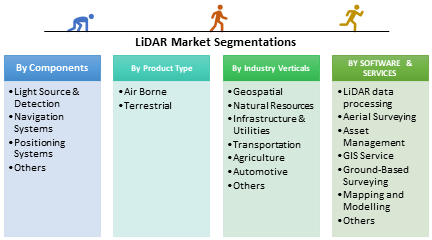The global LiDAR Market has accounted to $1,811.5 Million in 2023 and is estimated to grow at a CAGR of over 12 % during the forecast period of 2018 to 2023 majorly driven by the rising demand of mapping and surveying in various applications such as agriculture, infrastructure, transportation, and corridor mapping. The technological superiority of LiDAR compared to its alternatives along with the capability to provide enhanced efficiency with reduced human efforts is expected to drive the market growth in the near future.
What is LiDAR?
LiDAR stands for light detection and ranging or it can also be defined as laser imaging detection and ranging It is a remote sensing method in which light is used in the form of a laser to measure variable distances to the earth. It is a combination of
3D scanning and
laser scanning hence sometimes it can be defined as
3D laser scanning. LiDAR can be segmented into three types they are Solid-State LiDAR, Airborne LiDAR, and Terrestrial LiDAR. Some of the benefits of using LiDAR technology are the ability to capture large amounts of area in a relatively small amount of time and low requirement of manual labor. LiDAR mapping system uses the most convenient technique to cover or scan the area which is called as drone lidar survey. LiDAR systems collect information by sending thousands of pulses of light per second and by calculating the time it takes for the pulse to reach the LiDAR sensor. This results in the accurate analysis and 3D description of geometric structures.
LiDAR can provide accurate information even in the case of obstructions such as bridges and tunnels. LiDAR in automobiles is used in self-driving cars as it can provide visibility in all directions all the time. The precise distance of the objects in relation with the car can be precisely known through LiDAR technology. Geospatial industry is expected to witness significant growth when compared to other segments and is expected to reach $706.7 million by 2023. LiDAR systems that incorporate a micro electro mechanical system (MEMS) scanner have a high signal to background ratio which results in high performance.
This report incorporates an in-depth analysis of the LiDAR market by component, product type, software & services, market share, industry verticals, and geography. The major components of LiDAR technology in the scope of this report includes light source & detection, navigation and position systems. The market by product type has been presented into two sub-segments namely airborne and terrestrial.
What are the major applications for LiDAR technology?
The various industry verticals assessed in this report include automotive, environment, infrastructure & utilities, geospatial, transportation, and defense & aerospace industries among others. LiDAR technology is being used in both manned and unmanned aerial systems. They are also used in inertial navigation systems to calculate the exterior orientation and for geo-referencing and in military & law enforcement for vehicle speed measurement.
LiDAR technology is used for many applications in various domains such as archaeology, agriculture, infrastructure and automotive. They are majorly employed in high-resolution 3D cameras, handheld 3D scanner, corridor mapping, laser imaging software, drone lidar survey and so on. LiDAR technology finds its application in forest management which helps in measuring the vertical structure of the forests as well as mapping the ground beneath it. Airborne LiDAR is used in applications such as Flood modeling, pollution modeling, urban planning & management. They are extensively used for visualization in game developing and metrology due to their ability to recreate any kind of environment.

Market Research and Market Trends of LiDAR Ecosystem
- The advancements of latest technologies such as single-photon and Geiger-mode LiDAR is expected to change the market drastically in the near future as they are effective particularly in the aerial mapping
- In 2017, The United States Geological Survey (USGS) Broad Agency has announced the launch of 3D Elevation Program (3DEP) initiative according to which high quality topographic data and a wide range of three dimensional representations of the natural and constructed features of the country has to be gathered with the help of LiDAR technology over an 8 year period
- Scientists at National Oceanic and Atmospheric Administration (NOAA) of the United States are planning to incorporate the usage LiDAR technology in order to increase the accuracy of the weather forecast
- LiDAR technology has provided enormous opportunities for autonomous cars as it can create 360 degrees high-resolution 3D view of the surrounding area and also developed products such as lidar rangefinder which offers accurate and fast ranging up to the wide distance. This is expected to have a huge impact on the market in the near future.
Who are the Major Players in the LiDAR market?
The companies referred to in the market research report include Faro Technologies Inc, Velodyne LiDAR, Leica Geosystems AG, Quanergy LiDAR Systems Inc, Riegl Laser Measurement Systems GmbH, Teledyne Technologies Inc and so on
What is our report scope?
The report incorporates in depth assessment of the competitive landscape, product market sizing, product benchmarking, market trends, product developments, financial analysis, strategic analysis and so on to gauge the impact forces and potential opportunities of the market. Apart from this the report also includes a study of major developments in the market such as product launches, agreements, acquisitions, collaborations, mergers and so on to comprehend the prevailing market dynamics at present and its impact during the forecast period 2018-2024.
All our reports are customizable to your company needs to a certain extent, we do provide 20 free consulting hours along with purchase of each report, and this will allow you to request any additional data to customize the report to your needs.
Key Takeaways from this Report











Comments (0)
Post a Comment